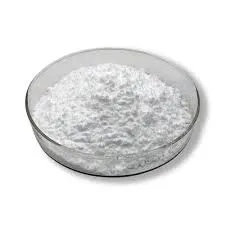
Dec . 18, 2024 06:01 Back to list
what is hpmc
Understanding HPMC A Multifunctional Polymer
Hydroxypropyl Methylcellulose (HPMC) is a versatile polymer derived from cellulose, a natural polymer found abundantly in plant cell walls. As an ingredient, HPMC is widely utilized across various industries, including food, pharmaceuticals, cosmetics, and construction. Its unique properties make it a crucial component for numerous applications, making it a subject of interest for both manufacturers and consumers alike.
Chemical Structure and Properties
HPMC is a semi-synthetic polymer resulting from the modification of cellulose through chemical processes. The cellulose backbone is hydroxypropylated and methylated, which enhances its solubility in water and helps modify its viscosity and thermal stability. This modification creates a structure that is capable of forming gels and films, leading to its diverse functionalities.
One of the most notable properties of HPMC is its ability to dissolve in both cold and hot water, creating a clear, viscous solution. The viscosity can be adjusted based on the degree of substitution and the molecular weight of the polymer. HPMC solutions are stable over a wide range of pH levels, making them suitable for various formulations, from acidic foods to neutral pharmaceuticals.
Applications in Food Industry
In the food industry, HPMC serves multiple purposes. It acts as a thickener, emulsifier, and stabilizer, enhancing the texture and shelf life of food products. For instance, HPMC is commonly used in gluten-free baking as a binding agent to improve dough consistency and elasticity. Additionally, it is employed to create low-fat and sugar-free products by providing a desirable mouthfeel without adding calories.
HPMC is also a vegan-friendly ingredient, making it a popular choice in plant-based foods. Its ability to mimic the properties of eggs and fats allows manufacturers to produce healthier options without compromising taste or texture.
Pharmaceutical Applications
what is hpmc

In pharmaceuticals, HPMC plays a critical role as a coating agent and controlled-release excipient. It is often used to coat tablets and capsules to improve swallowing, mask unpleasant odors, and enhance stability. Furthermore, HPMC is essential in creating sustained-release formulations that ensure the gradual release of active ingredients in the body, leading to improved therapeutic outcomes.
The use of HPMC in ophthalmic preparations as a lubricant is another significant application. Its gel-forming capacity helps retain moisture in the eye, providing relief for patients suffering from dry eye syndrome.
Industrial and Cosmetic Uses
Beyond food and pharmaceuticals, HPMC has found its way into construction and cosmetic products. In the construction industry, it is utilized as a thickening and water-retaining agent in cement and tile adhesives, improving workability and adhesion. In cosmetics, HPMC serves as a film-forming agent, stabilizer, and thickener, contributing to the texture and performance of creams, lotions, and gels.
Safety and Regulatory Status
HPMC is generally recognized as safe (GRAS) by the U.S. Food and Drug Administration (FDA), and it is permitted for use in food applications worldwide. Its non-toxic and non-allergenic properties make it suitable for a wide range of consumers, including those with dietary restrictions. Regulatory bodies across various regions, including the European Food Safety Authority (EFSA), have approved HPMC for diverse applications, reiterating its safety and efficacy.
Conclusion
In conclusion, Hydroxypropyl Methylcellulose (HPMC) is a multifaceted polymer that has become an essential ingredient in multiple industries. Its unique properties, safety profile, and versatility make it a valuable component in food products, pharmaceutical formulations, and various industrial applications. As innovation continues to flourish, the demand for HPMC and its applications will likely expand, reinforcing its significance in modern formulations. As consumers become more aware of ingredient functionality, understanding HPMC's role will empower them to make informed choices in the products they consume and use.
-
Versatile Hpmc Uses in Different Industries
NewsJun.19,2025
-
Redispersible Powder's Role in Enhancing Durability of Construction Products
NewsJun.19,2025
-
Hydroxyethyl Cellulose Applications Driving Green Industrial Processes
NewsJun.19,2025
-
Exploring Different Redispersible Polymer Powder
NewsJun.19,2025
-
Choosing the Right Mortar Bonding Agent
NewsJun.19,2025
-
Applications and Significance of China Hpmc in Modern Industries
NewsJun.19,2025







